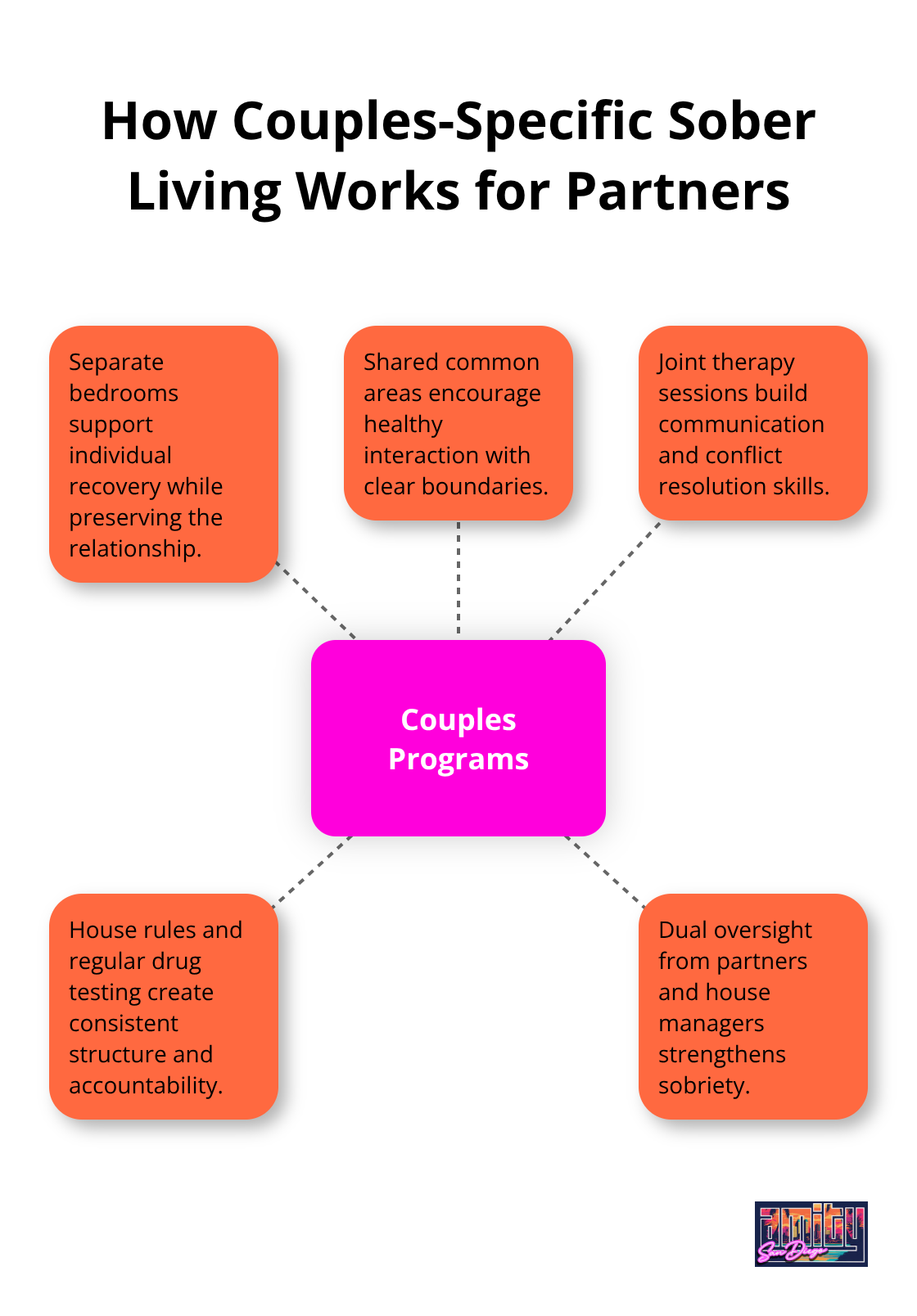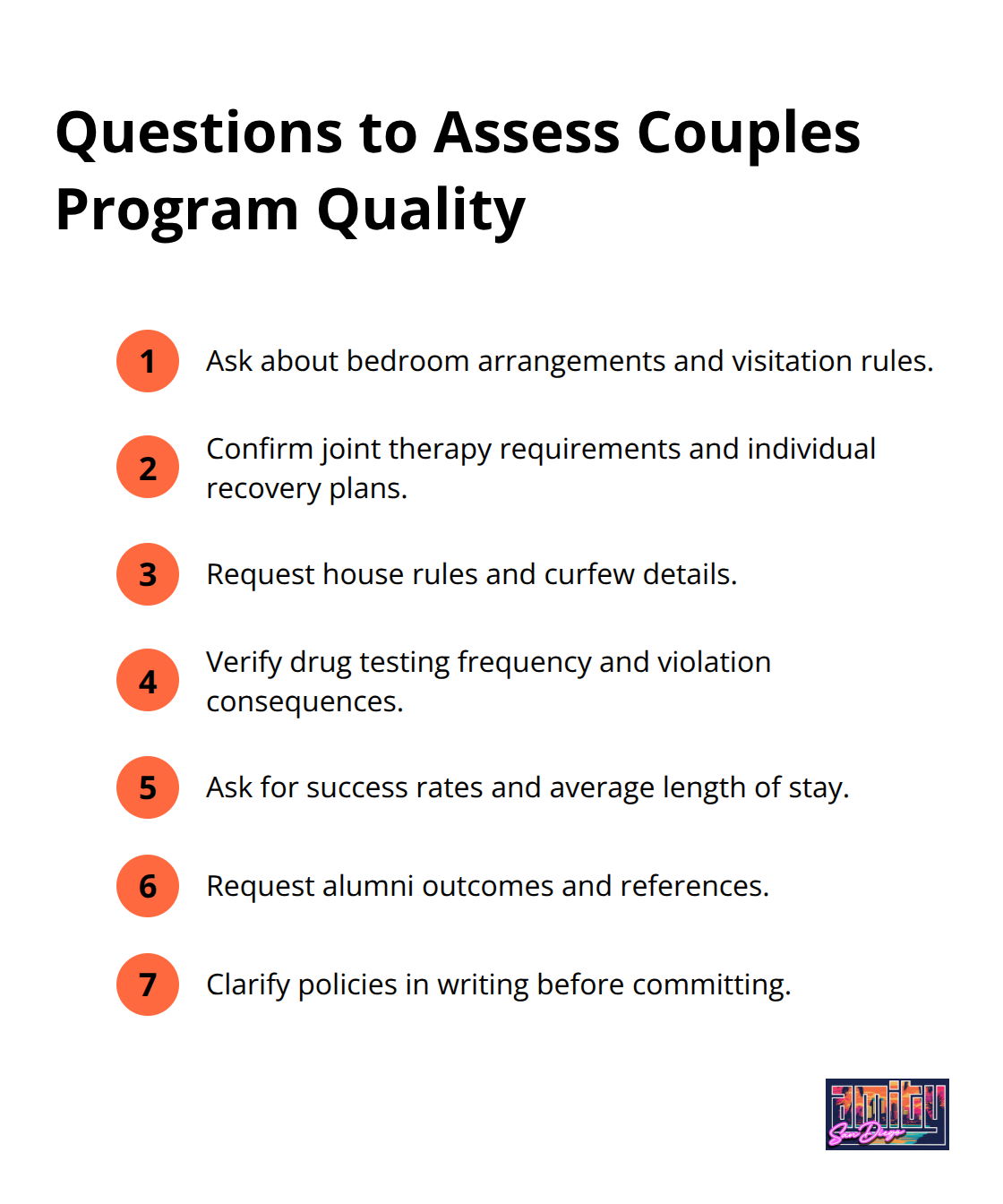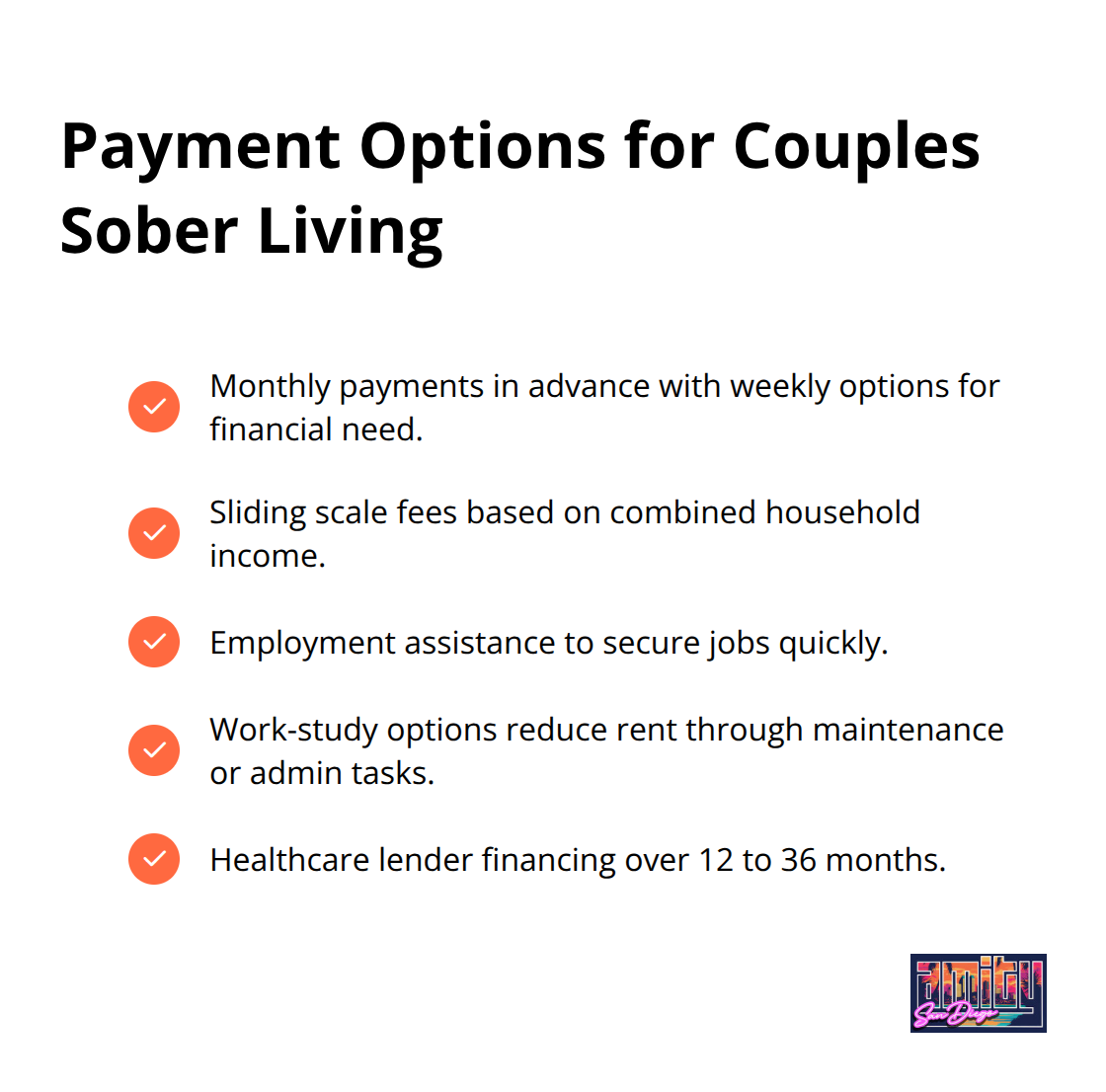Finding sober living homes for couples requires careful research and planning. These specialized facilities offer unique benefits for partners committed to recovery together.
We at Amity San Diego understand the importance of maintaining healthy relationships during the recovery process. The right sober living environment can strengthen your bond while supporting individual growth and sobriety goals.
What Makes Sober Living Different for Couples
Sober living homes operate as structured, substance-free environments where residents follow house rules, attend mandatory meetings, and submit to regular drug testing. Research shows individuals in sober living facilities demonstrate significant decreases in substance use at 6, 12, and 18-month intervals compared to those without structured support. Most facilities require residents to stay at least five nights per week, maintain employment or education, and participate in household responsibilities while they pay monthly rent (which averages $900 per room in California).
Standard Co-Ed vs Couples-Specific Arrangements
Most traditional sober living homes discourage romantic relationships because they create distractions from individual recovery work. Standard co-ed facilities typically house men and women separately with strict interaction policies. However, couples-specific programs operate under different principles. These specialized facilities require couples to maintain separate bedrooms while they allow shared common areas and joint therapy sessions.

The National Alliance for Recovery Residences reports that sober living residents come from various referral sources, but couples programs specifically target partners who completed treatment together and want to continue recovery as a unit.
Accountability Systems That Work
Couples-focused sober living creates dual accountability layers that standard facilities cannot match. Partners monitor each other’s sobriety while house managers track both individuals through mandatory check-ins and testing protocols. This system produces measurably better outcomes because couples report enhanced communication skills and conflict resolution abilities after shared sober living experiences. The structured environment teaches practical relationship skills through daily interactions, house meetings, and joint participation in recovery programs.
Admission Requirements and Selection Criteria
Facilities with couples programs typically maintain stricter admission requirements than standard sober living homes. These programs require proof of relationship stability and individual treatment completion, which makes them more selective but potentially more effective for committed partners. Most couples-specific facilities also mandate that both partners complete detox and primary treatment before admission. This careful screening process helps facilities maintain their success rates while they create environments where couples can focus on recovery without the chaos that untreated addiction brings to relationships.
For those seeking comprehensive support, addiction treatment San Diego offers specialized programs designed to help couples navigate recovery together.
How to Research and Find Quality Sober Living Homes
The California Department of Health Care Services maintains the most comprehensive directory of licensed sober living facilities, but this database lacks specific filters for couples programs. Start with the National Alliance for Recovery Residences website, which provides accreditation standards and facility search tools that help identify quality programs. The Substance Abuse and Mental Health Services Administration offers a treatment locator that includes sober living options, though you must call individual facilities to confirm couples accommodations. Sober living costs range from $400 to $800 monthly for basic facilities, making cost research essential before you contact programs.
Questions That Reveal Program Quality
Ask facilities about their specific couples policies, including bedroom arrangements, visitation rules, and joint therapy requirements. Quality programs require both partners to complete primary treatment before admission and maintain individual recovery plans alongside couple-focused activities. Request detailed information about house rules, curfew policies, drug testing frequency, and consequences for violations. The best facilities provide transparent answers about their success rates, average length of stay, and alumni outcomes. Programs that hesitate to share specific policies or outcomes data typically lack the structure needed for successful couples recovery.

Warning Signs of Substandard Facilities
Avoid facilities that allow couples to share bedrooms immediately upon admission, as this arrangement often leads to codependency rather than individual growth. Programs that don’t require proof of completed treatment or maintain loose admission standards create unstable environments where relapse becomes more likely. Facilities with unclear fee structures, no written policies, or managers who cannot explain their treatment philosophy lack the professionalism needed for serious recovery work. Any program that promises unrealistic outcomes or refuses facility tours should be eliminated from consideration immediately.
Verification Steps for Legitimate Programs
Contact the National Alliance for Recovery Residences to verify facility accreditation status and check for any complaints or violations. Request references from former residents (quality programs maintain alumni networks and can provide appropriate contacts). Visit facilities in person to assess cleanliness, safety measures, and overall atmosphere. Programs that operate transparently welcome tours and answer questions directly about their policies and procedures.
Once you identify potential facilities that meet your standards, the next step involves understanding the financial commitment and payment options available for couples programs. For comprehensive addiction treatment San Diego resources, explore specialized programs that support both individual and couples recovery.
What Will Couples Pay for Sober Living
Understanding Real Costs for Two People
Couples sober living programs cost significantly more than individual placements because facilities require separate bedrooms and specialized staff. The average cost of drug rehab is $13,475, with cheapest inpatient options at $6,000 monthly. Luxury programs exceed $8,000 monthly while basic shared arrangements start around $1,400. These costs include housing, utilities, case management, and group sessions, but exclude individual therapy which adds $120 to $200 per session. Most facilities require first month’s rent plus security deposits that range from $500 to $1,500 per person upon admission.
Insurance Reality Check for Couples Programs
Insurance coverage for sober living remains extremely limited regardless of your plan type. Most major insurers classify sober living as housing rather than medical treatment, which makes direct reimbursement impossible. However, insurance may cover associated outpatient therapy, psychiatric services, and medication management that occurs alongside sober living placement. Some facilities partner with intensive outpatient programs that qualify for insurance benefits (this reduces overall costs by $400 to $800 monthly). Veterans Affairs provides housing allowances through specific programs, while Medicaid waiver programs in California offer limited sober living support for qualified individuals.
Payment Plans and Financial Solutions
Most quality facilities require monthly payments in advance, but many offer weekly payment options for couples who demonstrate financial need. Many treatment centers offer sliding scale fees based on combined household income, which are flexible fees that adjust based on your income and financial situation. Employment assistance programs help residents secure jobs quickly, with facilities reporting average placement times of three weeks. Some programs offer work-study arrangements where residents perform facility maintenance or administrative tasks in exchange for reduced rent (these arrangements can cut monthly costs by $200 to $500). Credit financing through specialized healthcare lenders provides payment plans that span 12 to 36 months, though interest rates typically range from 8 to 15 percent annually.

For those seeking comprehensive addiction treatment San Diego options, understanding these financial considerations helps couples make informed decisions about their recovery journey.
Final Thoughts
Couples must have honest conversations about individual recovery goals and relationship expectations before they enter sober living homes for couples. Pack only essential items and prepare for strict house rules that may feel restrictive initially but create the structure you need for lasting sobriety. Recovery changes relationship dynamics significantly, and partners must learn to communicate without substances while they build trust through consistent actions rather than promises.
Many couples find they need individual therapy alongside joint sessions to address personal trauma and codependency patterns that contributed to their addiction. Success after sober living depends on how well you maintain the accountability systems and healthy routines you develop during your stay. Create detailed relapse prevention plans that include specific triggers, warning signs, and emergency contacts (most successful couples continue support groups and therapy sessions for at least 12 months after they leave structured housing).
We at Amity San Diego provide comprehensive outpatient programs that support couples throughout their recovery journey. Our evidence-based treatment approach combines individual and group therapy with holistic wellness programs that strengthen both personal sobriety and relationship health. The transition from sober living to independent life requires ongoing professional support to maintain the progress you achieve together, and addiction treatment San Diego programs offer the specialized care couples need for long-term success.

